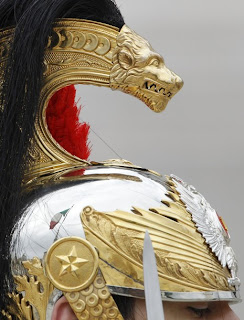La Citta Eterna was very quiet, a National Holiday, a sunny early morning but quickly the clouds came in.
At 09:00 the President of the Republic Giorgio Napolitano made his way to Piazza Venezia and the Altar to the Nation built in 1890 to honor the first King of Italy Vittorio-Emmanuelle II. The President laid a wreath at the feet of the Goddess Roma. The Vittoriano is the largest all white marble monument build in modern times, it occupies the area formely occupied by the hill of the Arx.
close up of a Corazzieri, the personal bodyguard of the President of the Italian Republic.
Italian President Giorgio Napolitano laying a wreath at the Vittoriano.
Then the President of the Republic went to the Pantheon, built in antiquity by Agrippa the able general and friend of Emperor Augustus. At the Pantheon waiting for him was the entire Royal Family of Italy, who nowadays live in Savoy-Piemonte in their former estate. At the Pantheon is the bronze mausoleum of King Vittorio-Emmanuelle II built from melted Austrian cannons, there he laid a second wreath to the King.
The Royal Family of Italy at the Pantheon in front of the tomb of their forefather King Vittorio-Emmanuelle II.
Then he went to the Gianicolo Hill across the Tiber to the mausoleum of Anita Garibaldi the heroic wife of Giuseppe Garibaldi, who fought and accompanied her husband during the war of independence. She died on the battlefield, it is also said that she was the one who taught her husband how to ride a horse.
The tomb of Anita Garibaldi on the Gianicolo Hill
The President then returned to Piazza Repubblica for a mass for Italian Soldiers in the Church of Santa Maria degli Angeli, formely the Baths of Emperor Dioclitian. This evening all the museums and major monuments of Rome are open to the public late. The President is at the Teatro del Opera di Roma for a gala presentation of Verdi's, Nabucco. This 17 March is a unique holiday celebrated this year only for the 150th anniversary and it was the idea of President Napolitano to do this. Bravo Presidente e Grazie!
Auguri a tutti!
At 09:00 the President of the Republic Giorgio Napolitano made his way to Piazza Venezia and the Altar to the Nation built in 1890 to honor the first King of Italy Vittorio-Emmanuelle II. The President laid a wreath at the feet of the Goddess Roma. The Vittoriano is the largest all white marble monument build in modern times, it occupies the area formely occupied by the hill of the Arx.
Italian President Giorgio Napolitano laying a wreath at the Vittoriano.
Then the President of the Republic went to the Pantheon, built in antiquity by Agrippa the able general and friend of Emperor Augustus. At the Pantheon waiting for him was the entire Royal Family of Italy, who nowadays live in Savoy-Piemonte in their former estate. At the Pantheon is the bronze mausoleum of King Vittorio-Emmanuelle II built from melted Austrian cannons, there he laid a second wreath to the King.
The Royal Family of Italy at the Pantheon in front of the tomb of their forefather King Vittorio-Emmanuelle II.
Then he went to the Gianicolo Hill across the Tiber to the mausoleum of Anita Garibaldi the heroic wife of Giuseppe Garibaldi, who fought and accompanied her husband during the war of independence. She died on the battlefield, it is also said that she was the one who taught her husband how to ride a horse.
The tomb of Anita Garibaldi on the Gianicolo Hill
The President then returned to Piazza Repubblica for a mass for Italian Soldiers in the Church of Santa Maria degli Angeli, formely the Baths of Emperor Dioclitian. This evening all the museums and major monuments of Rome are open to the public late. The President is at the Teatro del Opera di Roma for a gala presentation of Verdi's, Nabucco. This 17 March is a unique holiday celebrated this year only for the 150th anniversary and it was the idea of President Napolitano to do this. Bravo Presidente e Grazie!
Auguri a tutti!




wow!
ReplyDeleteI didn't know there were any more royals in Italy!?
Yes and quite a few Princes of all the families that made Rome.
ReplyDeleteWhen I took a history of the Papacy, it seemed integrally linked to the h/o Rome, particularly the families.
ReplyDelete